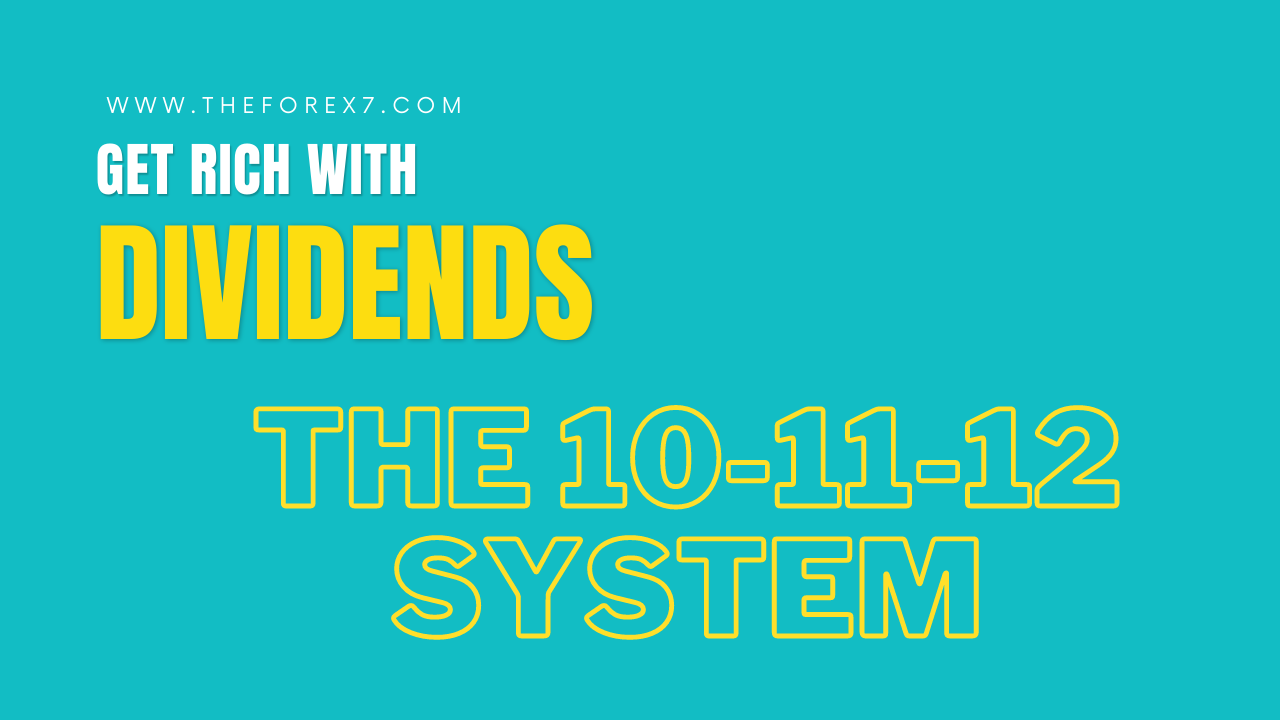Why Dividends Stock?
Purpose of dividends stocks, Explain briefly about Dividends stock
Course: [ GET RICH WITH DIVIDENDS : Chapter 1: Why Dividends Stock? ]

On the pages that follow is the recipe for generating 11% yields and 12% average annual returns for your portfolio. Significantly more if the stock market or your particular stocks cooperate.
WHY DIVIDEND STOCKS?
Let me start by making a bold
statement: The ideas in this book are one of the most important gifts you can
give to yourself or your children. On the pages that follow is the recipe for
generating 11% yields and 12% average annual returns for your portfolio.
Significantly more if the stock market or your particular stocks cooperate.
I’m not trying to brag. I wasn’t the
one who thought up this strategy. I just repackaged it in a compelling,
easy-to-read book that you will want to buy more copies of for all your friends
and family. Or at least lend them yours.
If you follow the ideas in this book
and teach them to your children, it’s very conceivable that many of your
concerns about income in the future will be over. And perhaps just as
important, if your children learn this strategy at a young age, they may never
have financial difficulties. They will have the tools to set themselves up for
income and wealth far before they are ready to retire.
Keep in mind that I cannot teach you or
your kids how to save. If you would rather buy a new car at the expense of
putting money away, I can’t and won’t attempt to fix that. This book is for the
people who already know how to save and are trying to make that money work as
hard as they do.
As far as saving money is concerned,
the only advice I’ll offer can be found in one of my favorite finance books,
The Richest Man in Babylon, by George S. Clason. In that book, first published
in 1926, Clason writes: “For every ten coins thou placest in thy purse take out
for use but nine. Thy purse will start to fatten at once and its increasing
weight will feel good in thy hand and bring satisfaction to thy soul.”
Many personal finance gurus proclaim the
same advice, but with a more modern bent to it, stating “Pay yourself first.”
Even if you are not able to save 10% of
your current income, saving anything is crucial. As you will see, the money you
save and invest using the ideas in this book will grow significantly over the
years. So if you can only save 8% or 5% or even 2%, start doing it now. And if
you get a raise or an inheritance or win the football pool, do not spend a dime
of it until you have put away 10% of your total income.
Here are some scary statistics.
According to the Employee Benefits Research Institute, only 14% of Americans
believe they will have enough money to retire comfortably. Even worse, 60% of
workers reported household savings of less than $25,000.
If you are serious about improving your
family’s financial future—and I know you are because you’re investing the time
to read this book—start saving today, if you haven’t already.
Imagine if you saved 10% of your money
and put it into the kinds of dividend stocks discussed in this book. Over time,
your wealth should grow to the point that it will have generated significant
amounts of income, perhaps even replacing the need to work.
This is the last point I will make
about saving. You didn’t spend your money on this book (or drive all the way to
the library) just to have me beat you up about saving. Instead, I will assume
you really are serious about securing your future and want to learn how to take
those funds and add a few zeros to the end of the total number in your
portfolio.
And if you’re already retired and need
income right away, the strategies in this book can help you too. You may not
have the ability to compound your wealth, but you can invest in companies that
will generate more and more income for you every year. Not only can you beat
inflation, but you can also give yourself and even your loved ones an extra
cushion.
There are lots of ways to invest your
hard-earned money. But you’ll soon see why investing in dividend stocks is a
conservative way to generate significant amounts wealth and income. This isn’t
theory. It’s been proven over decades of market history.
Some people believe that real estate is
the only way to riches. Others say the stock market is rigged so that the only
people who make money are the professionals—therefore, you should be in the
safety of bonds. Still others only trust precious metals. None of these beliefs
is true at all.
Within the stock market, there are
various strategies that are valid. Value investors insist you should buy stocks
when they’re cheap and sell when they’re expensive. Growth investors believe
you should own stocks whose earnings are growing at a rapid clip. Momentum
investors suggest throwing valuation out the window and investing in stocks
that are moving higher—and getting out when they stop climbing.
Still others only trust stock charts.
They couldn’t care less what a company’s earnings, cash flow, or margins are.
As long as it looks good on the chart, it’s a buy.
Each of these methodologies works at
some point. Value and growth strategies tend to switch on and off: One will be
in favor while the other is out until they trade places. For one stretch of
time, value stocks outperform. Then for another few years, growth will be
stronger. Eventually, value will be back in fashion.
Whichever is in vogue at the moment,
supporters of each will come up with all kinds of statistics that prove their
method is the only way to go.
The same dynamic applies when it comes
to fundamentals versus technicals. The technical analysts who read stock charts
assert that everything you need to know about a company is reflected in its
price and revealed in the charts. Fundamental analysts, who study the company’s
financial statements, maintain that technical analysis is akin to throwing
chicken bones and reading tealeaves.
There are plenty of other methodologies
as well. These include quantitative investing, cycle analysis, and growth at a
reasonable price (GARP) to name just a few more.
Diehard supporters of all these
strategies claim that their way is the only way to make money in the markets.
It’s almost like a religion whose most fanatical followers act as if their
beliefs are the only truth—period, no debate, end of story. They’re right and
you’re wrong if you don’t believe the same thing they do.
I’m no authority when it comes to
theology. But when it comes to investing I know this: Dogma does not work.
You will not consistently make money
investing only in value stocks. Again, sometimes they’re out of favor. If you
only read stock charts, sometimes you’ll be wrong. Charts are not crystal
balls.
Quantitative investing tends to work
until it doesn’t. Just ask the investors in Long Term Capital Management, who
lost everything in 1998.
Long Term Capital was a $4.7 billion
hedge fund that utilized complex mathematical models to construct trades. It
made a lot of money for investors for several years. It was supposed to be
fail-proof. But like the Titanic, which was also supposed to be unsinkable,
Long Term Capital hit an iceberg in the form of the Russian financial crisis
and nearly all was lost.
“Y’all Must’ve Forgot”
During his prime, legendary boxer Roy
Jones Jr. was one of the best fighters that many fans had ever seen. However,
Jones didn’t seem to get as much respect as he thought he deserved. So, in
2001, he released a rap song that listed his accomplishments and reminded fans
about just how good he was. The song was titled “Y’all Must’ve Forgot.” Roy was a much better fighter than he was a rapper.
The song was horrendous.
Looking back, investors in the mid- to
late 1990s remind me of boxing fans in 2001, when Roy released his epic tribute
to himself. Both groups seemed to have forgotten how good they had it—boxing
fans no longer appreciated the immense skills of Jones, while investors grew
tired and impatient with the 10.9% average annual returns of the Standard &
Poor’s (S&P) 500 (including dividends), since 1961. After decades of
investing sensibly, in companies that were good businesses that often returned money
to shareholders in the form of dividends, many investors became speculators,
swept up in the dot-com mania.
I’m not blaming anyone or wagging my
finger. I was right there with them. During the high-flying dot-com days, I was
trading in and out of Internet stocks too. My first “ten bagger”
(a stock that goes up ten times the original investment) was Polycom
(Nasdaq: PLCM). I bought it at $4 and sold some at $50 (I sold up and down
along the way).
However, like many dot-com speculators,
I got caught holding the bag once or twice as well. I probably still have my
Quokka stock certificate somewhere in my files. Never heard of Quokka? Exactly.
The company went bankrupt in 2002.
With stocks going up 10, 20, 30 points
or more a day, it was hard not to get swept up in hysteria.
And who wanted to think about stocks
that paid 4% dividends when you could make 4% in about five minutes in shares
of Oracle (Nasdaq: ORCL) or Ariba (Nasdaq: ARBA)?
Did it really make sense to invest in
Johnson & Johnson (NYSE: JNJ) at that time rather than eToys? After all,
eToys was going to be the next “category killer,” according to BancBoston
Robertson Stephens in 1999. Interesting to note that eToys was out of business
18 months later and BancBoston Robertson Stephens went under about a year after
that.
If, in late 1998, you invested in
Johnson & Johnson, a boring stock with a dividend yield of about 1.7% at
that time, and reinvested the dividends, in late 2011, you’d have made about
8.6% per year on your money. A $3,000 investment would have nearly tripled.
Johnson & Johnson is a real
business, with real products and revenue. It is not as exciting as eToys or
Pets.com or any of the hot business to business (B2B) dot-coms that took the
market by storm.
But 13 years later, are there any
investors who would complain about an 8.6% annual return per year? I doubt
there are very many— especially when you consider that the S&P 500’s annual
return, including reinvested dividends, was just 2% during the same period.
Now, you might have gotten lucky and
bought eBay (Nasdaq: EBAY) at $2 per share and made 16 times your money. Or
maybe you bought Oracle and made 5 times your money. But for every eBay and
Oracle that became big successful businesses, there were several Webvans that
failed and whose stocks went to zero.
In the late 1990s, the stock market
became a casino where many investors lost a ton of money and didn’t even get a
free ticket for the buffet. It doesn’t seem that we’ve ever completely returned
to the old way of looking at things.
My grandfather, a certified public
accountant who owned a seat on the New York Stock Exchange, didn’t invest in
the market looking to make a quick buck. He put money away for the long term,
expecting the investment to generate a greater return than he would have been
able to achieve elsewhere (and possibly some income).
He was willing to take risk, but not to
the point where he was speculating on companies with such ludicrous business
ideas that the only way to make money would be to find someone more foolish
than he to buy his shares. This is an actual—and badly flawed theory used by
some. Not surprisingly, it is called the Greater Fool Theory.
There were all kinds of companies,
TheGlobe.com, Netcentives, Quokka, to name just a few, whose CEOs declared we
were in a new era: This time was different. When I asked them about revenue,
they told me it was all about “eyeballs.” When I
pressed them about profits, they told me I “didn’t understand the new paradigm.”
Maybe I didn’t (and still don’t). But I
know that a business has to eventually have revenue and profits. At least a
successful one does.
I’m 100% certain that if Grandpa had
been an active investor in those days, he wouldn’t have gone anywhere near
TheGlobe.com.
One principle that I believe many
investors have forgotten is that they are investing in a business. Whether that
business is a retail store, a steel company, or a semiconductor equipment
manufacturer, these are businesses run by managers, with employees, customers
and equipment and, one hopes, profits. They’re not just three- or four-letter
ticker symbols that you enter into Yahoo! Finance once in a while to check on
the stock price.
And these real businesses can create a
significant amount of wealth for shareholders, particularly if the dividend is
reinvested.
According to Ed Clissold of Ned Davis
Research, if you invested $100 in the S&P 500 in at the end of 1929, it
grew to $4,989 in 2010 based on the price appreciation alone. However, if you
reinvested the dividends, your $100 grew to $117,774. Clissold says that 95.8%
of the return came from dividends.1 (See
Figure 1.1.)
Figure 1.1 1929-2010: $100 Original Investment
Marc Lichtenfeld’s Authentic Italian Trattoria
Years ago, my wife and I were in
Ashland, Oregon. We loved the town and started talking about escaping the rat
race, moving to Ashland, and opening a pizza place. We’ve repeated that conversation
on trips to Banff in the Canadian Rockies, Asheville, North Carolina, and even
Tel Aviv, Israel.
Considering that I know nothing about
how to run a restaurant, would be unhappy if not in close vicinity to a major
American city, and am a lousy cook, the pizza joint remained a happy fantasy.
But for the purposes of this book, Marc
Lichtenfeld’s Authentic Italian Trattoria will serve as an example of a
business with revenue and profits. We’re also going to assume that I’m your
brother-in-law (your sister was always a very good judge of character) and
you’ve agreed to become my partner in the business.
One day I come to you, my favorite
brother/sister-in-law, with my plans for the restaurant. I have the space lined
up. It’s in a popular location with a lot of foot traffic. I’ve been talking
with a wonderful young chef who is eager to make an impression on local diners
and critics. All that’s missing is start-up capital.
This is where you come in. In exchange
for a $100,000 investment, you will receive a 10% ownership stake. I show you
my projections: The restaurant will break even the first year, make $100,000 in
the second year and $200,000 in the third year.
One of the questions you may have is
how you’ll get your money back. Do you have to wait for the restaurant to be
sold, or will you receive some of the profit each year?
If I tell you that my goal is to build
the business to $1.5 million in sales and then sell it for two times sales ($3
million), where you’ll receive $300,000, your response might be very different
from what it would be if I tell you that half the profits will be invested back
in the business with the other half split up among the partners in a yearly
payout (dividend).
Your decision on whether to give me the
money will depend in part on your goals. Are you willing to speculate that
you’ll receive the big payoff in several years when the business is sold, or
would you rather receive an income stream from your investment but no exit
strategy (plan to sell the restaurant)?
When buying stocks, investors have to
make similar decisions. Do they buy a stock with the sole purpose of selling it
higher down the road, or do they buy one that provides an income stream and
opportunities for income growth in addition to capital gains?
I don’t know about you, but if I’m
investing in someone’s business, I want to see some money as soon as possible
rather than wait for an exit strategy.
Here is another factor that might
affect your decision to invest in my trattoria: Instead of offering to pay you
your cut of the profits ever year, I might offer to reinvest that money back
into the restaurant and give you more equity. That way, your piece of the
profits gets larger each year. Eventually, you can start receiving a
significant cash payout on an annual basis or receive a bigger slice of the pie
when you sell your stake in the business because your equity has increased
above your original 10%.
This last scenario is the same as
reinvesting dividends, a method that is the surest way I know of to create
wealth.
And what I love about this strategy is
that it works (and has worked) no matter who is President of the United States;
what hap-pens in Europe, Iran, or the Middle East; unemployment; inflation; and
so on. Sure, those things will impact your short-term results, but over the
long haul, they mean nothing and in fact could help you accumulate more wealth,
as I’ll explain in the section on bear markets in Chapter 3.
GET RICH WITH DIVIDENDS : Chapter 1: Why Dividends Stock? : Tag: Stock Market : Purpose of dividends stocks, Explain briefly about Dividends stock - Why Dividends Stock?

